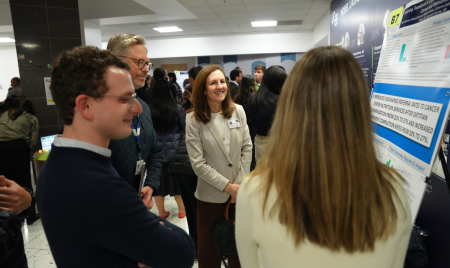UCSF Residents Work in Mobile Clinic Supporting the Healthcare Needs of the City’s Underserved
SOS recently secured permanent, affordable housing in San Francisco for client, Alvaro, and constant canine comp-anion, Max. SOS also connected Alvaro with SFCCC member clinics for geriatric and dental care, while VET SOS provided free veterinary services to Max and coordinated his service animal licensing. After spending the last 20 years without a regular roof over his head, Alvaro can now be seen looking for furniture and artwork to decorate their new home. (Photo credit: Marlena Hartman-Filson)
“Would you like to be seen by a doctor?”
I’m standing on the softball field at James Rolph Jr. Park, a recreational field just a few blocks from Zuckerberg San Francisco General Hospital. For my friends and I, the field is a place of silliness and friendly competition in a local kickball league.
But today, staff and volunteers of the Street Outreach Services (SOS) program are here to see homeless patients. The mobile clinic, run by San Francisco Community Clinic Consortium, has been serving the City since 1988. In addition to reaching over 1,000 San Franciscans per year, clinic staff mentor over 50 medical residents, medical students, and nursing students from UCSF and other schools.
“Good to see you again!” Manny Gonzalez, SOS Outreach Manager, jokes with familiar faces, calling many by first name.
“Do you stay here?” asks Daniel Wlodarczyk, MD, UCSF clinical professor and specialist in internal medicine. As we step on the field, we are stepping into someone’s home. Groundskeepers are watering the grass. Manny and Dr. Wlodarczyk are distributing water bottles.
Five days weekly, the team travels across the city, reconnecting with patients who either do not have insurance, or who cannot attend their appointments in clinic. The team visits dusty highway underpasses and homeless encampments, looking for patients who have fallen through the cracks of our healthcare system.
By some estimates, the homeless population in San Francisco is roughly 7,500. Typically, the mobile van clinic team treats people with skin infections, foot problems from poorly fitting shoes, issues related to substance use disorders, untreated mental health problems, and medical concerns such as high blood pressure and diabetes.
“They threw my tent into the trash,” one man says. He has a chronic disease that requires urgent attention, but hasn’t seen a physician in a year. “My cell phone was in there. I can’t get in contact with the hospital.”
Under Proposition Q, San Francisco city officials are authorized to remove homeless encampments on city sidewalks after giving residents 24-hour notice and an offer of housing.
Inside the mobile clinic van, Dr. Wlodarczyk searches for the patient’s electronic medical record. He had been scheduled for an appointment earlier this summer, but without a cell phone, hadn’t been able to find the exact location. The team makes another appointment for that week and gives clear instructions.
Throughout the afternoon, Sam Gilmore, an outreach worker, distributes safer injection kits and refers patients to treatment program options. Manny sees a patient with a dog and refers him to SOS’ veterinary program, Vet SOS.
Dorlee Chavez, a volunteer nurse, examines patients and provides food. A grateful man says he doesn’t want to see a doctor but takes the food with a smile, “Can I call you Mom? Thank you!”
The team stops across the city, drawing from experience and personal connections to meet patients. By the end of the afternoon, the team sets appointments for three HIV-positive homeless individuals who had been unable to attend their last appointments.
Dr. Wlodarczyk later told me that all three patients attended their scheduled appointments within two days. “When you come to where a patient stays and have a conversation with them, they feel valued. And together, you can form a partnership to take ownership of their health.”
In medical school, I’ve heard physicians debate whether they’d rather have HIV or diabetes, because modern antiviral therapy has made the average lifespan of a treatment-compliant HIV patients the same as HIV-negative individuals.
Despite these advances, homeless patients still suffer without medical attention, sometimes only because they leave “address” and “phone number” blank on their patient intake forms.
As medical students in the UCSF Bridges Curriculum, we are taught to understand disease from a systems perspective. *A working-class man in San Francisco requires surgery and is prescribed opiates. He becomes dependent on opiates and loses his job and home. At night he’s robbed and suffers post-traumatic stress disorder, so he sleeps during the day. While asleep, he doesn’t notice a Public Works citation to move his tent, and then loses all his possessions, including his cell phone and medical records. He doesn’t see a physician for years until the SOS mobile clinic pulls up to his tent.
Yet, as students, we also see firsthand how difficult it is to change these unjust structures. “When patients are no shows, many burnt out physicians welcome the break,” Dr. Wlodarczyk tells me, “And if there is no address or cell phone to contact, physicians move onto the next patient. It’s no one’s fault. It’s just the system.”
Urgency gets blunted by long hours, leading to cynicism. But as students, we have role models too—examples of how to remain idealistic as we grow and advance in our medical training.
“This is what it takes. So we need to do it,” says Dr. Wlodarczyk. “Let’s go! We have to hurry. I want to follow up with our final patient.”
Manny presses the accelerator and the lumbering van lurches to a top speed of what feels like 25 miles per hour. Sam pulls out a GPS and routes us to a dusty alleyway behind a grocery store.
*Details changed to protect patient anonymity









